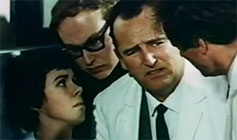|
|
|
|
Beyond Reason
|
 |
|
Giorgio Mangiamele
(1926-2001) is a key figure in the history of Australian independent filmmaking
– independence understood in aesthetic, economic, ethical and political terms.
He was not without moments of acclaim and recognition during his lifetime – his
feature Clay was selected for Cannes in
1965 – but he spent too many years battling funding obstacles and institutional
indifference toward his major projects, while (a common story among artists)
trying to eke out a living. Still photography and documentary filmmaking (in
Papua New Guinea) occupied him, on the margins of the burgeoning movie
industry, for many years; the so-called Australian Renaissance of the 1970s, as
well as the 10BA tax-deduction phase of the ‘80s, passed him by.
Scott Murray has rightly remarked: “Australia was too ageist, too narrow in its view about what sort of films ought to be made, for there to be space for a sensitive, inventive, deeply-passionate filmmaker like Mangiamele”. As a result of this neglect at home, few programmers or critics in other countries have – so far – picked up the trail of Mangiamele’s traces. It’s a sad and insufficient after-life observable in many similar cases, such as the Cypriot-Australian Anna Kannava.
In many respects an
emblem of the adventure of Australian multiculturalism in mainly its bad,
disadvantageous days, Mangiamele’s life and work have been slowly rediscovered,
assembled, appreciated and promoted in
toto by successive waves of scholars (including Gino Moliterno and Silvana
Tuccio), researchers (Chris Luscri), cinephiles (Quentin Turnour) and artists
(Ettore Siracusa who, when young, worked on several of Giorgio’s films).
An invaluable DVD
containing four key works, produced by the Australian Film and Sound Archive
and distributed by Ronin Films, appeared in 2011; Senses of Cinema paid tribute to Mangiamele at the moment of his passing in 2001.
To give you a
glimpse of the type of filmmaker – and person – Giorgio was: when, at the
tender age of 19, I was assigned to view and write about his Beyond Reason for inclusion in a chapter
of Murray’s book The New Australian
Cinema (1980), it was a formidable and somewhat imperious Giorgio who
himself rocked up to the private projection room with a 35mm print under his
arm – and an obviously well-rehearsed and considered speech to give me (and
only me!) about the film, his intentions for it, and his work as a whole.
Thanks, Giorgio! It was the only time I interacted directly with him, although
I have since spoken at length to various of his friends, supporters, colleagues
and family members.
Different to the
poetic art cinema of Clay, Beyond Reason is an attempt to marshal a
commercial genre template for non-generic ends: the hope (sometimes in vain) of
many an experimental filmmaker! It is a low-budget science-fiction project – Mangiamele
described it as “shot in a couple of weeks for TV” – but, crucially, a
philosophically and intellectually-minded variant of the genre, well outside
the Roger Corman-style B movie/exploitation template: a sophisticated variant
that was to become prevalent and fashionable decades later in minimalistic ‘indie’
works like Shane Carruth’s Primer (2004).
The doctors and
patients of an asylum (the actors include Maggie Copeland, George Dixon, Louise
Hall and Ray Fellow) are locked together in an underground shelter (filmed at
the educational institution RMIT) while nuclear war rages above. Tuccio has
proposed, in her 2009 PhD on the director, that the film signals a “shift in
perspective” in Mangiamele’s career, but not an abandonment of his previously
established concerns; rather, there is a strategic displacement, for the
“issues pertinent to the status of foreigner” (the stranger, the social
outcast) are now treated allegorically, under a different guise.
Otherness (the principal theme of his cinema) is
rendered here in psychological rather than racial-cultural terms – but within a
politically inflected framework of psychology that reflects intellectual
tendencies of the period (in Australia as elsewhere, heavily influenced by
Herbert Marcuse and Wilhelm Reich – the traces of this orientation can be found
in many issues of the 1970s film magazine Lumiere).
More on its
surface, the question of this lightly essayistic drama (co-written by
well-known Melbourne film-scene activist Bob Garlick) is: how do we define
madness (another prime question posed by the radicals of the time)? An
individual can never be analysed separately from the others around him or her,
for it is with these others that each person develops a particular
configuration of need, demand and desire. There can be no distinctions between
doctor and patient, asylum and the world at large. All people are caught in the
image created for them by others. It’s a small anticipation of the cinema of
Rainer Werner Fassbinder, in a nutshell!
The mise
en scène choreographs action carefully to emphasise choral-like
arrangements of figures, rather than this or that particular, psychologised
individual. These are types rather than characters; bundles of symptoms rather
than personality traits. Sexuality is presented in extremes of frigidity and
nymphomania; aggression runs on a scale from sadism to masochism.
Beyond
Reason is a schematic but valiant attempt at describing social relations in the light of
Freudian psychoanalysis – and a fascinating glimpse (a low quality print can be
viewed at www.rarefilmm.com/2021/02/beyond-reason-1970-upgrade/)
of an artistic filmmaker trying to find his way forward in what was, at the
time, a sparse and forbidding national-industrial context.
© Adrian Martin 1980 / April 2022 |
![]()